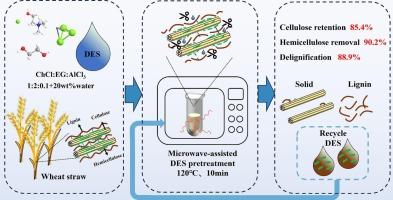A synergistic microwave-assisted hydrated deep eutectic solvent (DES) pretreatment for efficient fractionation of wheat straw
IF 7.1
2区 环境科学与生态学
Q1 ENGINEERING, ENVIRONMENTAL
引用次数: 0
Abstract
The disadvantages of deep eutectic solvents (DES) under their high viscosity and long reaction time make their application in industrial production challenging. In this study, the synthesized DES was coupled with a microwave hydrated method for efficient lignocellulose (wheat straw) grading. To mitigate the viscosity of the DES system and reduce the consumption of DES reagents, water was introduced into the synergistic pretreatment process. Under optimized reaction condition (120 °C, 20 % w/w water), we achieved a delignification efficiency of 88.9 %, hemicellulose removal of 90.2 %, and cellulose retention of 85.4 %. Results indicated that the appropriate reaction pressure during pretreatment facilitated the efficient fractionation of lignocellulosic components. The primary structural alteration in lignin was the cleavage of β-O-4 linkages, and the recovered lignin exhibited a more uniform molecular weight distribution. Furthermore, water addition was found to protect the lignin H-type units from structural degradation. The recovered DES, when recycled for two cycles, retained its efficiency, achieving 77.77 % hemicellulose removal and 74.59 % lignin removal. Therefore, the developed synergistic pretreatment method enables rapid and effective fractionation of lignocellulosic biomass under mild conditions, besides, the reuse of DES maintains a high pretreatment performance while significantly reducing the consumption of chemical reagents.

微波辅助水合深度共晶溶剂(DES)预处理麦秸高效分馏研究。
深共晶溶剂粘度大、反应时间长等缺点给其在工业生产中的应用带来了挑战。在本研究中,将合成的DES与微波水合法相结合,用于木质纤维素(麦秸)的高效分级。为了降低DES体系的粘度,减少DES试剂的消耗,在协同预处理过程中引入了水。在优化的反应条件下(120°C, 20% w/w水),脱木质素效率为88.9%,半纤维素去除率为90.2%,纤维素保留率为85.4%。结果表明,预处理过程中适当的反应压力有利于木质纤维素组分的有效分离。木质素的主要结构改变是β-O-4键的断裂,回收的木质素表现出更均匀的分子量分布。此外,还发现加水对木质素h型单元的结构降解有保护作用。回收的DES经过两次循环后,其半纤维素去除率达到77.77%,木质素去除率达到74.59%。因此,所开发的协同预处理方法可以在温和的条件下快速有效地对木质纤维素生物质进行分馏,并且DES的再利用在保持较高的预处理性能的同时显著降低了化学试剂的消耗。
本文章由计算机程序翻译,如有差异,请以英文原文为准。
求助全文
约1分钟内获得全文
求助全文
来源期刊

Waste management
环境科学-工程:环境
CiteScore
15.60
自引率
6.20%
发文量
492
审稿时长
39 days
期刊介绍:
Waste Management is devoted to the presentation and discussion of information on solid wastes,it covers the entire lifecycle of solid. wastes.
Scope:
Addresses solid wastes in both industrialized and economically developing countries
Covers various types of solid wastes, including:
Municipal (e.g., residential, institutional, commercial, light industrial)
Agricultural
Special (e.g., C and D, healthcare, household hazardous wastes, sewage sludge)
 求助内容:
求助内容: 应助结果提醒方式:
应助结果提醒方式:


